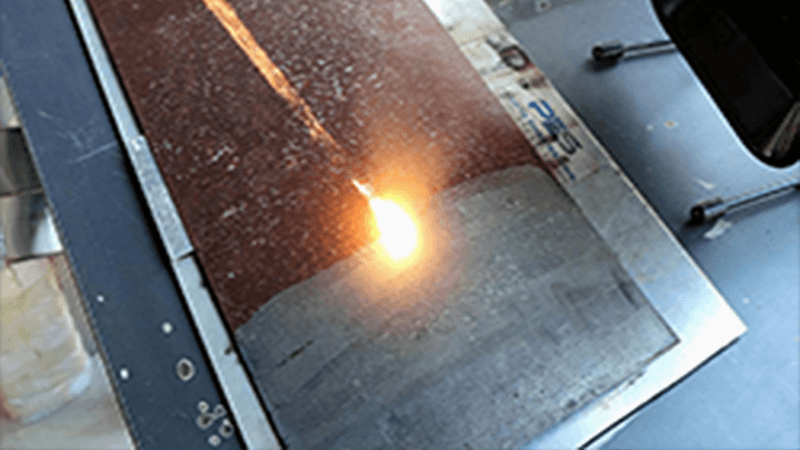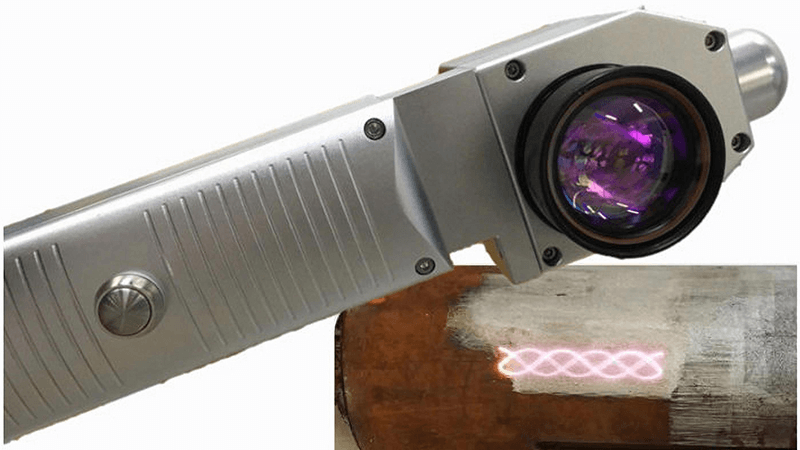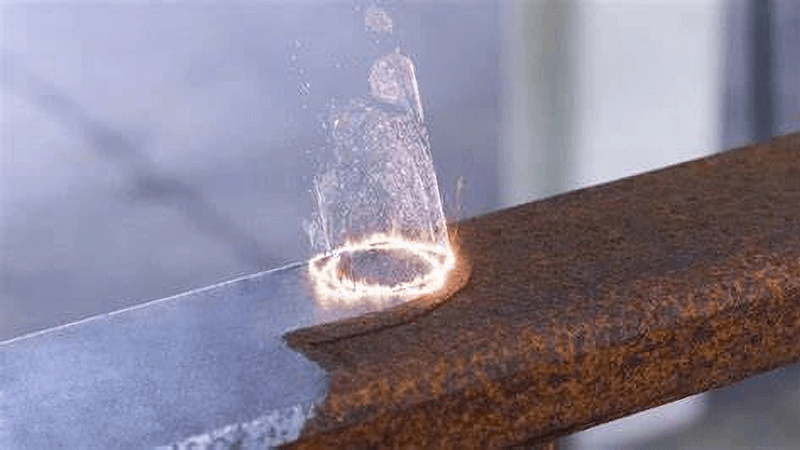When rust, paint, or grease builds up, traditional cleaning methods can be slow, messy, and damaging. Many businesses struggle with costly downtime and inconsistent results that hurt production quality.
A water-cooled pulsed laser cleaning machine works by delivering short, high-energy laser pulses that break down contaminants without harming the base material, while water cooling prevents overheating for stable long-term use.
For companies like automotive, aerospace, or manufacturing, switching to laser cleaning changes the game. Let me explain the details from Kirin Laser’s perspective.

What is pulse cleaning?
Old methods like sandblasting and chemical treatments often create secondary waste and risk damaging the material. Buyers want a solution that is precise, fast, and eco-friendly.
Pulse cleaning is a method where short bursts of laser energy target surface contaminants, causing them to vaporize or detach while leaving the underlying material intact.
How Pulse Cleaning1 Works
Pulse cleaning uses controlled energy delivery. Each laser pulse creates a quick energy spike that heats and lifts away rust, oil, or coatings. Since the energy is applied in micro-bursts, the base material stays unaffected. This makes it safe for delicate metals, molds, and precision tools.
Advantages of Pulsed Laser Cleaning
| Feature | Benefit for Industry |
|---|---|
| Controlled energy bursts | Protects base material |
| High precision | Ideal for complex shapes and surfaces |
| Dry process | No chemicals or secondary waste |
| Eco-friendly | Cleaner workplace and lower disposal |
My Perspective
I worked with a mold manufacturer who constantly battled with buildup that damaged tooling. Once they switched to Kirin Laser pulsed cleaning2, they reduced cleaning time by half. More importantly, the molds lasted longer. This proved to them that pulsed cleaning was not only efficient but also protective of their core assets.

Can laser cleaning remove paint?
Factories that recondition parts often spend hours scraping or burning off paint. These methods can be inconsistent, costly, and harmful to workers.
Yes, laser cleaning can remove paint effectively by breaking the bond between the coating and the surface without mechanical force or harmful chemicals.
Why Laser Cleaning Excels in Paint Removal
Paint layers absorb laser energy differently than the base material. When the pulses hit the coating, they cause rapid heating and micro-explosions that detach the paint layer. The base remains smooth and unaffected. This method is faster and cleaner than solvents or abrasives.
Paint Removal Comparison
| Method | Downsides | Laser Cleaning Advantage3 |
|---|---|---|
| Chemical | Hazardous waste, safety issues | No chemicals, safer for workers |
| Sandblasting | Material damage, dust production | Gentle on surfaces, clean process |
| Manual tools | Labor intensive, inconsistent | Fast, precise, automated |
My Experience
I remember working with a railway parts supplier who had to strip paint before re-coating steel plates. Their old chemical process required hours of soaking and cleaning. With Kirin Laser pulsed cleaning4, the same task took minutes. Workers avoided toxic fumes, and the company cut costs on chemicals. It was a win on all sides.

What power do you need for laser cleaning machine?
One of the most common questions buyers ask is about power. Too little power makes cleaning inefficient. Too much power risks damaging the part or wasting energy.
The power needed for a laser cleaning machine depends on the material and contamination type, typically ranging from 100W for light cleaning to over 2000W for industrial heavy-duty applications.
Matching Power to Application
- 100W–200W: Suitable for light rust, thin paint, or delicate parts
- 300W–500W: Common choice for general industrial use
- 1000W–2000W+: Heavy-duty cleaning for large, thick coatings or stubborn rust
Kirin Laser offers modular power options5. This ensures that clients can choose the right machine for their production scale, instead of overpaying for unnecessary power.
Power Selection Guide
| Application | Recommended Power Range | Notes |
|---|---|---|
| Jewelry, precision | 100W–200W | Gentle cleaning, high accuracy |
| Automotive parts | 300W–500W | Balance of speed and cost |
| Shipbuilding | 1000W–2000W+ | Large-scale rust and coating removal |
My Insights
When I guided an automotive client choosing between 500W and 1000W6, we analyzed their workload. They mainly handled engine parts with moderate rust. A 500W machine delivered the right balance of speed and cost. Over time, they expanded production, and upgrading to a 1000W module was easy because of Kirin Laser’s modular design. This flexibility is why our machines fit both small shops and big factories.

Does laser cleaning remove rust?
Rust is a constant enemy in industries that rely on metal components. Traditional methods like grinding create dust, damage surfaces, and reduce part lifespan.
Yes, laser cleaning removes rust effectively by targeting and vaporizing the oxidized layer, restoring the metal surface without abrasion or chemical treatments.
Why Laser Cleaning is Effective Against Rust
Rust absorbs laser energy better than bare metal. Each laser pulse quickly heats the oxidized layer, causing it to break away. The base metal reflects the beam, staying protected. This makes laser rust removal7 both safe and efficient.
Rust Removal Efficiency
| Rust Level | Laser Cleaning8 Performance |
|---|---|
| Light surface rust | Removed within seconds |
| Medium rust | Clean surface in several passes |
| Heavy corrosion | Requires high power, still safe |
My Story
One of my automotive clients struggled with rusted engine blocks. Sanding took hours and often damaged the surface. After adopting Kirin Laser’s water-cooled pulsed machine, they cleaned blocks in minutes. Downtime was reduced, and product quality improved. The client told me it was the first time they felt cleaning added value instead of being a burden.

Conclusion
A water-cooled pulsed laser cleaning machine 9 works by delivering powerful laser bursts that remove rust, paint, and contaminants without harming the base material. With water cooling, the machine runs reliably even in long shifts. From precision work to heavy-duty applications, Kirin Laser machines offer efficiency, customization, and proven results. For businesses, this technology is not just a tool, it is a path to higher productivity and cleaner operations.
-
Discover how pulse cleaning can efficiently remove rust and coatings without damaging delicate materials, enhancing your industrial processes. ↩
-
Discover how Kirin Laser's technology can enhance mold longevity and efficiency, offering a transformative solution for manufacturers facing buildup issues. ↩
-
Discover how laser cleaning can revolutionize your paint removal process with its efficiency and safety benefits. ↩
-
Learn about Kirin Laser's innovative technology that significantly reduces time and costs in paint removal. ↩
-
Explore how modular power options can enhance efficiency and cost-effectiveness in laser applications. ↩
-
Understanding the differences between 500W and 1000W machines helps optimize cleaning efficiency and cost for automotive parts with moderate rust. ↩
-
Explore various rust removal techniques to find the best solutions for your needs, including innovative methods like laser cleaning. ↩
-
Discover how Laser Cleaning can revolutionize rust removal, making it faster and more efficient for various applications. ↩
-
Find the best laser cleaning machine and laser cleaning solutions from Kirin Laser, clicking this link to get all your needs for your applications. ↩





